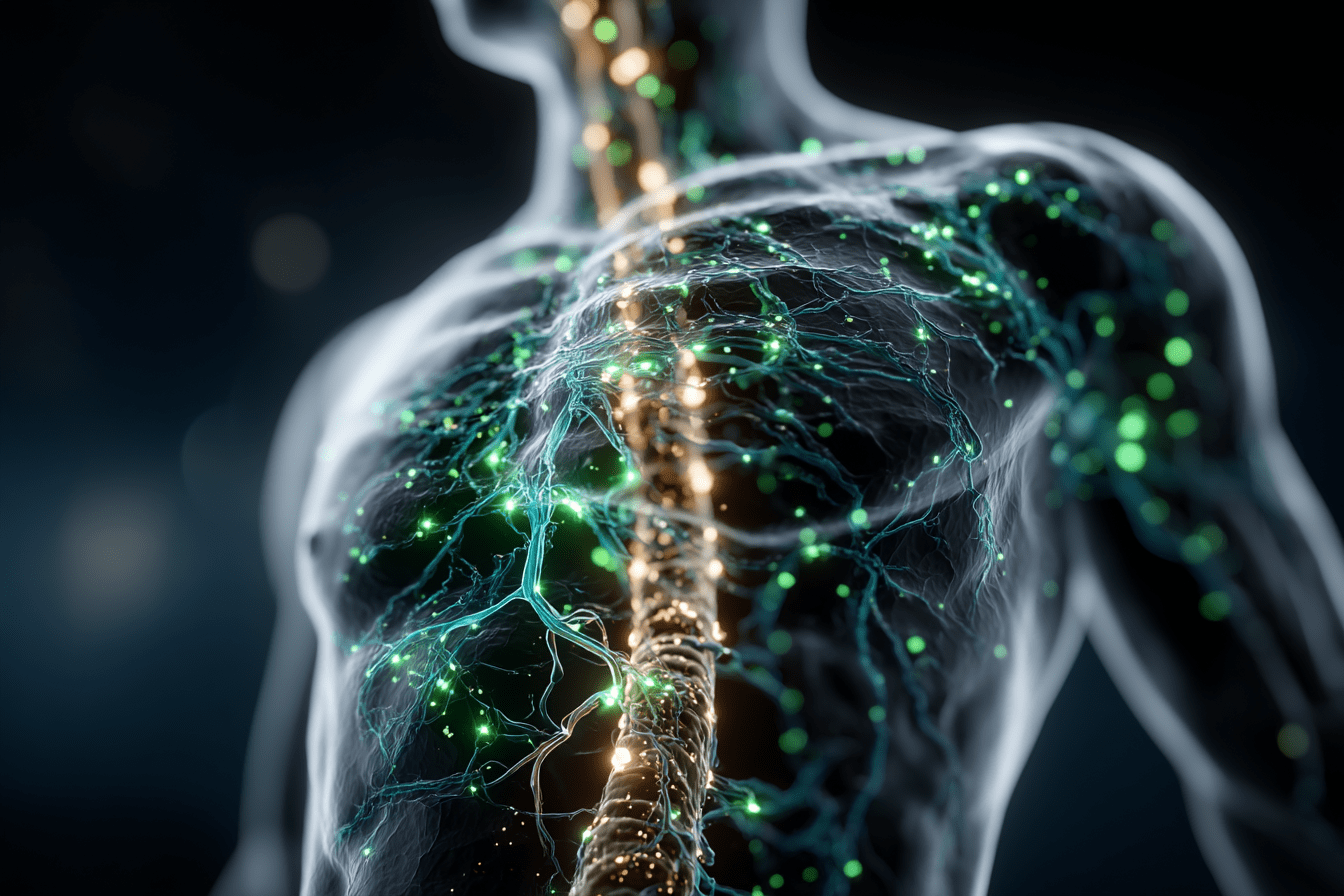- Home
- CHS Research
- Your Body's Own Cannabis Network

Your Body's Own Cannabis Network: The Endocannabinoid System's Role in CHS
You've probably heard that cannabis can help with nausea. So, finding out that long-term cannabis use can cause severe nausea and vomiting in the form of Cannabinoid Hyperemesis Syndrome (CHS) feels like a bizarre plot twist. To understand this paradox, we need to look inside – at your body's Endocannabinoid System (ECS).
This intricate system is a major player in the science behind CHS, and its disruption seems to be at the heart of the problem.
First Up: What Exactly IS the Endocannabinoid System (ECS)?
Think of the ECS as a vast communication network within your body. It's not just one organ; it's spread throughout your brain, organs, immune cells, connective tissues, and crucially for CHS, your entire digestive system. Its main job is to help maintain balance, or "homeostasis."
The ECS has three main components:
- Endocannabinoids: These are cannabis-like molecules produced naturally by your own body on demand (like anandamide and 2-AG).
- Cannabinoid Receptors: These are like docking stations on the surface of cells where endocannabinoids (and plant cannabinoids like THC) bind. The two main ones are CB1 and CB2 receptors.
- Enzymes: These are responsible for creating and breaking down endocannabinoids once they've done their job.
The ECS and Your Gut: Usually a Peacekeeper
Normally, the ECS plays a vital role in regulating gut function:
- Nausea Control: CB1 receptors are abundant in brain regions that control the vomiting reflex and also within the nerves of the gut. Activating these receptors typically suppresses nausea and vomiting signals.
- Gut Motility: The ECS helps regulate how fast food moves through your stomach and intestines.
- Stomach Acid: It influences the secretion of stomach acid.
- Inflammation: CB2 receptors, found more on immune cells in the gut, play a role in managing inflammation.
In essence, a well-functioning ECS helps keep your digestive system calm and balanced.
Enter External Cannabis (THC): Hijacking the System
When you consume cannabis, phytocannabinoids (plant-based cannabinoids), primarily THC, enter your system. THC strongly binds to CB1 receptors, essentially mimicking your body's own endocannabinoids but often with more potent and prolonged effects.
This is why cannabis can initially have beneficial effects on the gut, like reducing nausea – THC activates those anti-nausea pathways via CB1 receptors.
The CHS Twist: How Chronic Cannabis Use Disrupts the ECS
Here’s where the role of the Endocannabinoid System in CHS becomes critical and paradoxical. With long-term, heavy cannabis use, the constant barrage of THC seems to overwhelm and dysregulate the ECS:
- Receptor Overload & Downregulation: Imagine constantly yelling at someone – eventually, they might stop listening as effectively. Similarly, the constant, strong activation of CB1 receptors by THC might cause the body to protect itself by:
- Reducing the number of CB1 receptors available (downregulation).
- Making the existing receptors less sensitive to being activated (desensitization).
- Loss of Normal Regulation: When CB1 receptors become less responsive, the ECS loses its ability to properly regulate nausea and gut function. Your body's natural "off switch" for nausea might become faulty.
- Paradoxical Effects Emerge: Instead of suppressing nausea, the dysregulated system might start contributing to it. The normal signaling pathways get scrambled. It's like the system short-circuits, leading to the severe symptoms of CHS.
- Potential Impact on Endocannabinoid Levels: Some research suggests chronic THC might also alter the levels or balance of your body's own endocannabinoids, further contributing to the ECS dysregulation in CHS.
It's Like a Broken Thermostat
Think of the ECS in your gut like a thermostat regulating nausea. Normally, it keeps things comfortable. Acute cannabis use might turn the temperature down (reduce nausea). But chronic, heavy use seems to break the thermostat (dysregulate the ECS). Now, instead of controlling the temperature, the broken system contributes to wild swings (intense nausea and vomiting).
Connecting ECS Dysfunction to CHS Symptoms
This ECS dysregulation likely directly contributes to:
- The intense, cyclical nausea and vomiting (loss of normal anti-nausea control).
- The abdominal pain (potentially linked to altered gut motility or nerve signaling).
- The changes in gut motility sometimes observed in CHS.
Important Note: While ECS dysfunction is a central theory, it's likely interacting with other factors, like changes in TRPV1 receptors (the heat/spice receptors) and potentially individual genetic predispositions. CHS is complex!
Why Cessation Helps the ECS Recover
Stopping cannabis use removes the constant external THC stimulation. This gives the overloaded ECS a chance to gradually reset. Receptors may slowly return to normal numbers and sensitivity (upregulate), allowing the body to regain its natural balance over time. This is why cannabis cessation is the cornerstone of CHS recovery.
The Takeaway
The Endocannabinoid System is a critical player in the CHS story. Designed to maintain gut harmony, it appears to become severely disrupted by chronic heavy cannabis use, flipping from an anti-nausea system to one that contributes to the debilitating symptoms of CHS. Understanding this ECS connection highlights why removing the cannabis trigger is essential for allowing the system to heal and symptoms to resolve.
Did learning about the ECS shed some light on the CHS puzzle for you? Share your thoughts below!
Disclaimer: This article explains current scientific understanding for educational purposes. It is not medical advice. Consult a healthcare professional for any health concerns or treatment decisions regarding CHS.
